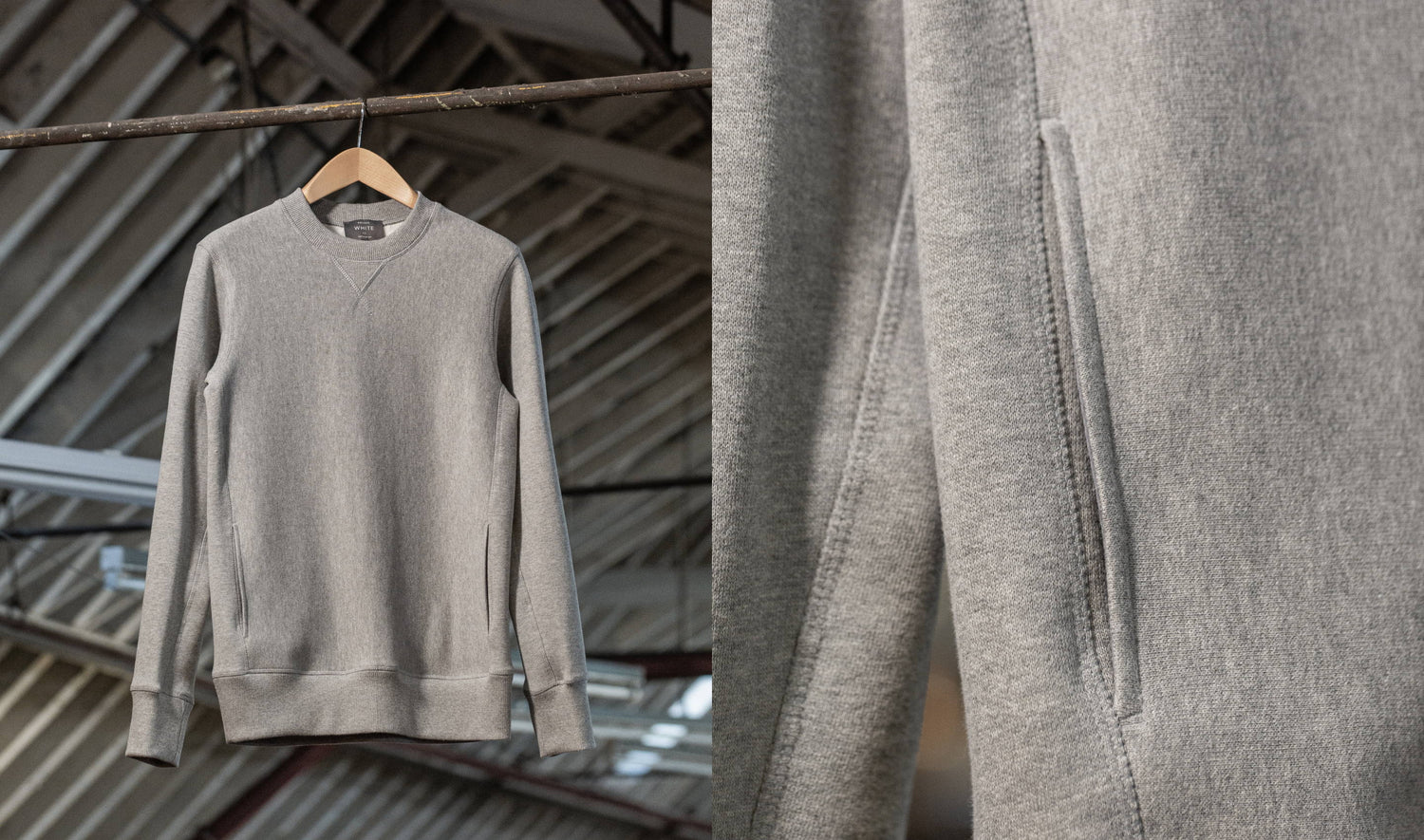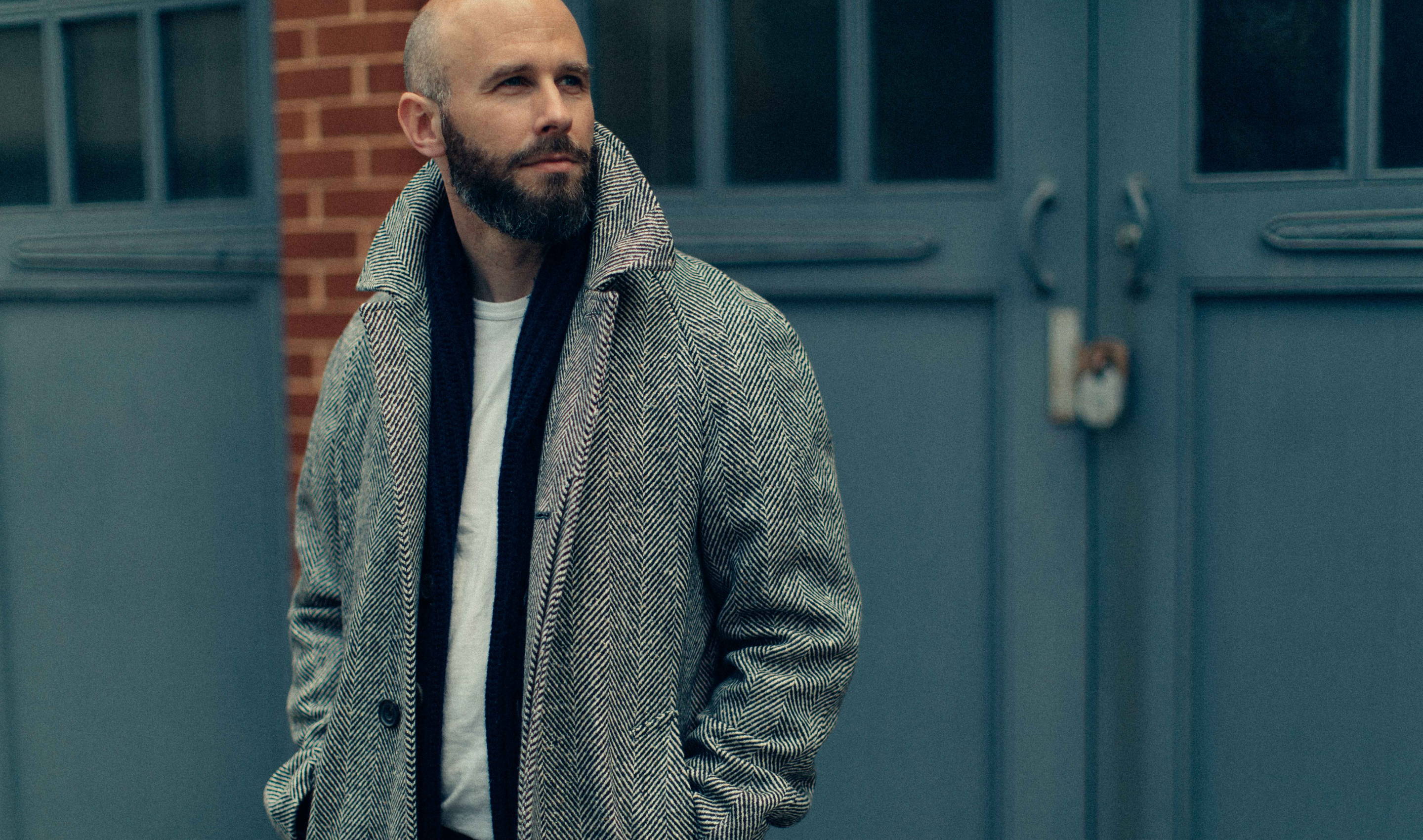No Sweat
While developing the jersey fabric that forms a key part of the new Flâneur loungewear collection, we have been fortunate enough to draw on the experience of one of the world’s leading experts in the field.
A master technician with over four decades in the industry, Andrew Shane has an innate knowledge of working with the material. Here he talks to us about his career highlights, the tradition of garment making in England and the satisfaction of collaborating on this new collection.
How did you start in the industry?
I was born in 1954 in a little place called Pinkston, on the border of Nottingham and Derbyshire. From Leicester to Hinckley to Nottingham was full of clothing factories and dying works - and the rest was coal mines. We grew up in a place where people made things.
I started in a factory at 16. The main department was the cutting room, which was incredible. I worked there first as an assistant, then as the cutting room manager – you had to learn fast how to cut, lay up, use a band knife, a straight knife and strip cut.
How did you first come to run a factory?
I wanted to find something new and with that confidence of youth, applied for a job setting up a small cutting room. I got it, but the place was so different. I think now you would probably call it a sweatshop. The workers were excellent though, but the work was inefficient and I got them working far more quickly.
We were working for a football shirt manufacturer who wanted to expand into rugby shirts. They asked me to set up and run a new factory. It was a bit of a jump, just an empty building with no phone lines or anything.
I’d also always thought how I might run a factory. For example, someone like my mum was always tired from full-time work and bringing up kids. So, I decided to allow people to work part-time, which nobody did in 1977. As a result, I had the pick of the best skills in the area, which made our factory one of the best.
That's where my journey started. It wasn't all straightforward and you have to be a problem solver. If something goes wrong in the factory – if it’s a member of staff or one of the machines, you have to resolve it. There’s no one else.
"The pocket work, the placket work, the collar work on our jersey is the best I've ever seen. That's because we’re bringing the quality of Private White V.C.’s cutting and stitching to jersey."
ANDREW SHANE, JERSEY JEDI
Who have you worked with over the years?
I worked for some exceptional brands from Paul Smith, and Burberry to Nigel Cabourn and Fred Perry. It has never felt like work. It’s always felt like some great adventure and an incredible joy.
One of the greatest privileges was working with one of Paul Smith’s designers, Derek Morton, who has been with the company from the 1970s. Derek lived quite close to our factory, so he’d drop in. He developed this great working relationship with one of our machinists called Doris. She could make anything just by having it explained to her. I must say working with Doris was another of my career highlights.
When we first started, of course, these big brands were much smaller. Take Paul Smith, we’d literally drop the goods off at his offices in Nottingham. They couldn't get things made in the big factories then.
What did you learn from the major brands you worked with?
We grew with these brands and with these people. Paul Smith, Nigel Cabourn are huge names now, but I’ve grown up with them.
I’ve also seen their attention to quality and detail. We benefitted from that because people would look at us and say it's good enough for them, it's good enough for me. We were trusted, and that was because I would never take a short cut on making any garment. If somebody said they didn’t like something, we would do our best to make sure it was resolved. So me and the factory established a good reputation.
What are the challenges of working with jersey?
With any material there are challenges and if you are skilled you know what to look for. For example, a trained cabinetmaker asks what type of wood it this? Which direction is the grain going? How will it change over time? Will it warp or twist?
It’s the same for jersey. It's got its own personality depending on how it’s knitted, so you ask how will it behave. It can get holes. It can shrink, it can twist, it can roll. There are so many different things.
How have the staff here handled this material?
The skills that already exist at Private White V.C. are for working with flat fabrics. That means that you push the fabric through flat with your left hand, but someone used to jersey will pick the fabric up and hold it to the machine. We've had to train everybody to handle the fabric differently.
The problem is, of course, that we didn’t have the luxury of practice fabric. This is cashmere, Merino wool, fine cotton. The commitment for any company to take on such an interesting, intricate job is rare.
What I have seen here, though, has been incredibly exciting. The combination of skills we’ve had to use and that experience with tailoring and with woven garments, has really influenced and enhanced the finish of these new jersey pieces in the collection.
The pocket work, the placket work, the collar work on our jersey is the best I've ever seen. That's because we’re bringing the quality of Private White V.C.’s cutting and stitching to jersey. The tailoring if you like. That means the result is probably better than I could have managed in my factory because of that tailoring background.
No Sweat
While developing the jersey fabric that forms a key part of the new Flâneur loungewear collection, we have been fortunate enough to draw on the experience of one of the world’s leading experts in the field.
A master technician with over four decades in the industry, Andrew Shane has an innate knowledge of working with the material. Here he talks to us about his career highlights, the tradition of garment making in England and the satisfaction of collaborating on this new collection.
How did you start in the industry?
I was born in 1954 in a little place called Pinkston, on the border of Nottingham and Derbyshire. From Leicester to Hinckley to Nottingham was full of clothing factories and dying works - and the rest was coal mines. We grew up in a place where people made things.
I started in a factory at 16. The main department was the cutting room, which was incredible. I worked there first as an assistant, then as the cutting room manager – you had to learn fast how to cut, lay up, use a band knife, a straight knife and strip cut.
How did you first come to run a factory?
I wanted to find something new and with that confidence of youth, applied for a job setting up a small cutting room. I got it, but the place was so different. I think now you would probably call it a sweatshop. The workers were excellent though, but the work was inefficient and I got them working far more quickly.
We were working for a football shirt manufacturer who wanted to expand into rugby shirts. They asked me to set up and run a new factory. It was a bit of a jump, just an empty building with no phone lines or anything.
I’d also always thought how I might run a factory. For example, someone like my mum was always tired from full-time work and bringing up kids. So, I decided to allow people to work part-time, which nobody did in 1977. As a result, I had the pick of the best skills in the area, which made our factory one of the best.
That's where my journey started. It wasn't all straightforward and you have to be a problem solver. If something goes wrong in the factory – if it’s a member of staff or one of the machines, you have to resolve it. There’s no one else.
Who have you worked with over the years?
I worked for some exceptional brands from Paul Smith, and Burberry to Nigel Cabourn and Fred Perry. It has never felt like work. It’s always felt like some great adventure and an incredible joy.
One of the greatest privileges was working with one of Paul Smith’s designers, Derek Morton, who has been with the company from the 1970s. Derek lived quite close to our factory, so he’d drop in. He developed this great working relationship with one of our machinists called Doris. She could make anything just by having it explained to her. I must say working with Doris was another of my career highlights.
When we first started, of course, these big brands were much smaller. Take Paul Smith, we’d literally drop the goods off at his offices in Nottingham. They couldn't get things made in the big factories then.
What did you learn from the major brands you worked with?
We grew with these brands and with these people. Paul Smith, Nigel Cabourn are huge names now, but I’ve grown up with them.
I’ve also seen their attention to quality and detail. We benefitted from that because people would look at us and say it's good enough for them, it's good enough for me. We were trusted, and that was because I would never take a short cut on making any garment. If somebody said they didn’t like something, we would do our best to make sure it was resolved. So me and the factory established a good reputation.
"The pocket work, the placket work, the collar work on our jersey is the best I've ever seen. That's because we’re bringing the quality of Private White V.C.’s cutting and stitching to jersey."
ANDREW SHANE, JERSEY JEDI
What are the challenges of working with jersey?
With any material there are challenges and if you are skilled you know what to look for. For example, a trained cabinetmaker asks what type of wood it this? Which direction is the grain going? How will it change over time? Will it warp or twist?
It’s the same for jersey. It's got its own personality depending on how it’s knitted, so you ask how will it behave. It can get holes. It can shrink, it can twist, it can roll. There are so many different things.
How have the staff at Private White V.C. handled this material?
The skills that already exist at Private White V.C. are for working with flat fabrics. That means that you push the fabric through flat with your left hand, but someone used to jersey will pick the fabric up and hold it to the machine. We've had to train everybody to handle the fabric differently.
The problem is, of course, that we didn’t have the luxury of practice fabric. This is cashmere, Merino wool, fine cotton. The commitment for any company to take on such an interesting, intricate job is rare.
What I have seen here, though, has been incredibly exciting. The combination of skills we’ve had to use and that experience with tailoring and with woven garments, has really influenced and enhanced the finish of these new jersey pieces in the collection.
The pocket work, the placket work, the collar work on our jersey is the best I've ever seen. That's because we’re bringing the quality of Private White V.C.’s cutting and stitching to jersey. The tailoring if you like. That means the result is probably better than I could have managed in my factory because of that tailoring background.
How hard has the process been to establish this new Private White V.C. factory?
I've loved it. I’ve been here quite a long time, about six months. It means I've got to know the people. There’s a real willingness to learn. To study the processes required, then to meet and examine the garments and adjust them accordingly. It’s been a pleasure to watch and develop together. That's what's exciting.
The whole process is complex, so we started from the beginning of it all. I would say the hardest thing is to make the machines and the handler flow until they’re perfect. They have been so keen to get it right, to keep practicing until they get it right. That is what this factory has. As I said they’ve brought the eye of a tailor and applied it to jersey – the machinists know what something should look like, all I’ve had to do is take the time to ensure they have the right skills.
Do you have a favourite pieces from this collection?
I love some of the basics - the t-shirts and so on – and the jacket and shirts are very fine pieces of clothing.
For me, though, the sweatshirt is awesome. I've made jersey in the United Kingdom for my entire life. I’ve worked for really big names, and, in my previous factory, made some wonderful pieces. This sweatshirt is better than anything I’ve made in my career. It's that good.
How hard has the process been to establish this new Private White V.C. factory?
I've loved it. I’ve been here quite a long time, about six months. It means I've got to know the people. There’s a real willingness to learn. To study the processes required, then to meet and examine the garments and adjust them accordingly. It’s been a pleasure to watch and develop together. That's what's exciting.
The whole process is complex, so we started from the beginning of it all. I would say the hardest thing is to make the machines and the handler flow until they’re perfect. They have been so keen to get it right, to keep practicing until they get it right. That is what this factory has. As I said they’ve brought the eye of a tailor and applied it to jersey – the machinists know what something should look like, all I’ve had to do is take the time to ensure they have the right skills.
Do you have a favourite pieces from this collection?
I love some of the basics - the t-shirts and so on – and the jacket and shirts are very fine pieces of clothing.
For me, though, the sweatshirt is awesome. I've made jersey in the United Kingdom for my entire life. I’ve worked for really big names, and, in my previous factory, made some wonderful pieces. This sweatshirt is better than anything I’ve made in my career. It's that good.
SHOP JERSEY
SHOP THE STORY






Leave a comment
This site is protected by hCaptcha and the hCaptcha Privacy Policy and Terms of Service apply.